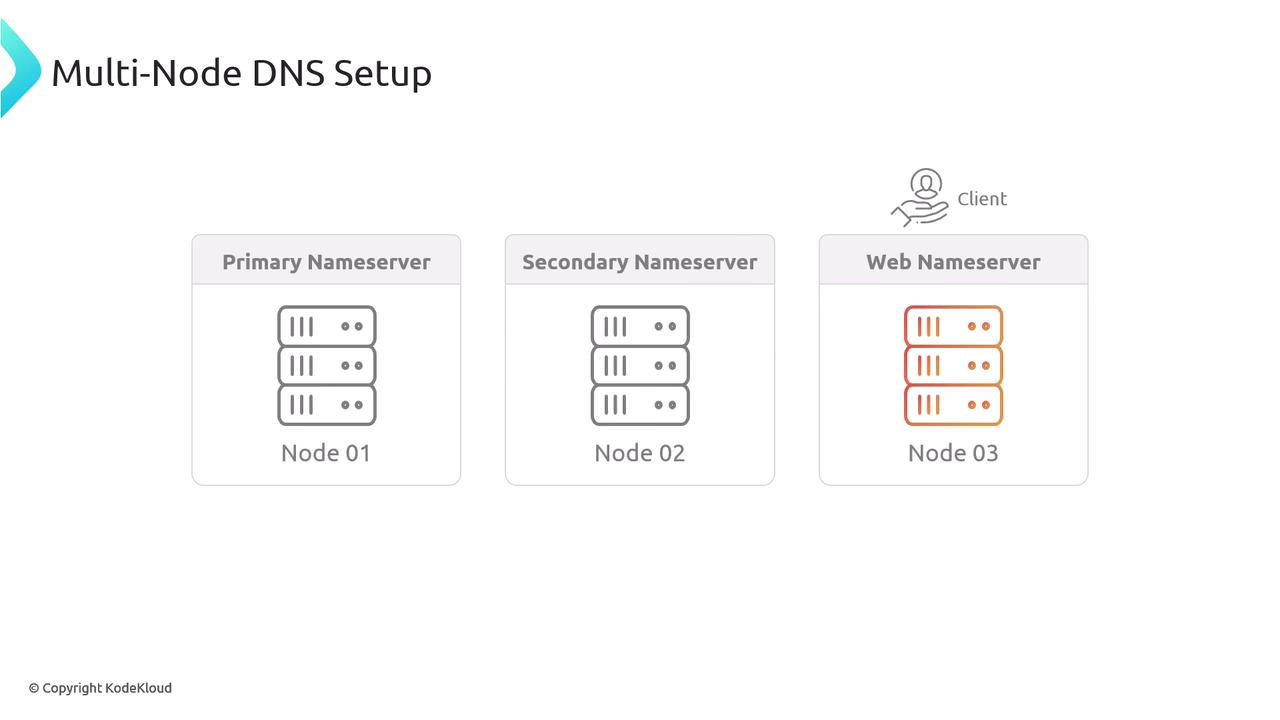Demystifying DNS
Final Project
Demo Setting Up DNS Server
In this guide, we will demonstrate how to configure a multi-node DNS setup consisting of two nameservers and one webserver that also acts as a client. The configuration details are as follows:
• node-01: Primary nameserver
• node-02: Secondary nameserver
• node-03: Webserver running an application (and acting as a client)
Below is an illustration of the multi-node DNS setup:

Primary Nameserver Setup (node-01)
Begin by installing and configuring BIND9 on node-01, which will serve as the primary nameserver.
1. Install and Start BIND9
Start the BIND9 service:
sudo systemctl start bind9
2. Configure the Zone File
Edit the zone configuration file (typically named.conf.local) to specify the zone information. In this example, our domain is multinode.kodekloud.lab and its zone file is stored in /etc/bind. The configuration should indicate that node-01 is the primary (master) server for the zone:
zone "multinode.kodekloud.lab" {
type master;
file "/etc/bind/db.multinode.kodekloud.lab";
};
Reminder
Gather the IP addresses for node-01 and node-02 before updating the zone file. These IP addresses will be used within the zone file.
3. Verify IP Addresses
Run the following commands to check the IP addresses of node-01 and node-02:
# Starting the named service if not already running
sudo systemctl start named
# Editing configuration and zone file
sudo vi /etc/bind/named.conf.local
sudo vi /etc/bind/db.multinode.kodekloud.lab
# Checking IP addresses:
ping node01
ping node02
Example output for node01:
PING node01 (192.5.84.8) 56(84) bytes of data.
64 bytes from node01 (192.5.84.8): icmp_seq=1 ttl=64 time=0.029 ms
And for node02:
PING node02 (192.5.84.10) 56(84) bytes of data.
64 bytes from node02 (192.5.84.10): icmp_seq=1 ttl=64 time=0.035 ms
4. Create the Zone File
Create the file /etc/bind/db.multinode.kodekloud.lab with the following content. This file sets the Start of Authority (SOA) record, NS records, and A records for node01, node02, and node03:
$TTL 604800
@ IN SOA node01.multinode.kodekloud.lab. admin.multinode.kodekloud.lab. (
1 ; Serial
604800 ; Refresh
86400 ; Retry
2419200 ; Expire
604800 ) ; Negative Cache TTL
@ IN NS node01.multinode.kodekloud.lab.
@ IN NS node02.multinode.kodekloud.lab.
node01 IN A 192.5.84.8
node02 IN A 192.5.84.10
node03 IN A 192.5.84.12
5. Restart and Verify
After saving the zone file, restart the BIND9 service:
sudo systemctl reload bind9
You can test the DNS resolution by querying the domain using the local nameserver:
# Test resolution using ping
ping node02
ping node03
# Querying with dig
dig @localhost multinode.kodekloud.lab
This should return the SOA along with the NS records, confirming that node-01 is correctly serving as the primary nameserver.
Secondary Nameserver Configuration (node-02)
Next, configure node-02 as the secondary (slave) nameserver.
1. Install BIND9 on node-02
SSH into node-02 and start the BIND9 service:
ssh node02
sudo systemctl start bind9
2. Confirm the Primary Server's IP
From node-02, verify the IP address of node-01:
ping node01
3. Configure the Secondary Zone
Edit the named.conf.local file on node-02 to declare it as a secondary nameserver. Use node-01's IP (192.5.84.8) as the master:
zone "multinode.kodekloud.lab" {
type slave;
file "/var/cache/bind/db.multinode.kodekloud.lab";
masters { 192.5.84.8; };
};
Save the file and reload BIND9:
sudo systemctl reload bind9
4. Configure Zone Transfer on the Primary (node-01)
Ensure that the named.conf.options file on node-01 allows transfers to node-02. An example configuration:
options {
directory "/var/cache/bind";
allow-transfer { 192.5.84.10; };
recursion yes;
allow-recursion { any; };
listen-on { any; };
};
Reload the service after making changes:
sudo systemctl reload bind9
5. Test the Secondary Setup
Verify node-02's configuration by querying for zone data:
# Query using dig on node-02 itself
dig @localhost multinode.kodekloud.lab
# Test full zone transfer using AXFR if permitted
dig @192.5.84.10 multinode.kodekloud.lab AXFR
If the zone transfer is successful, node-02 should return all the zone records.
Webserver (node-03) Configuration
Now, configure node-03 as the webserver and set it up to work with DNS.
1. Set Up Nginx on node-03
SSH into node-03, install Nginx, and start the service:
ssh node03
sudo systemctl start nginx
curl localhost
A successful response should display the default Nginx welcome page.
2. Add a CNAME Record for the Webserver
Update the zone file on the primary nameserver (node-01) by adding a CNAME record for the webserver. SSH into node-01 again and open the zone file /etc/bind/db.multinode.kodekloud.lab to include the following record:
$TTL 604800
@ IN SOA node01.multinode.kodekloud.lab. admin.multinode.kodekloud.lab. (
1 ; Serial
604800 ; Refresh
86400 ; Retry
2419200 ; Expire
604800 ) ; Negative Cache TTL
@ IN NS node01.multinode.kodekloud.lab.
@ IN NS node02.multinode.kodekloud.lab.
node01 IN A 192.5.84.8
node02 IN A 192.5.84.10
node03 IN A 192.5.84.12
www IN CNAME node03.multinode.kodekloud.lab.
After saving the updated file, reload BIND9:
sudo systemctl reload bind9
3. Update DNS Settings on node-03
On node-03, update the /etc/resolv.conf file to use node-01’s IP as the primary nameserver. An example resolv.conf might look like:
search us-central1-a.c.kk-lab-prod.internal c.kk-lab-prod.internal google.internal
nameserver 172.25.0.1
options ndots:0
4. Verify DNS Resolution
Finally, validate the full setup on node-03 by running:
curl www.multinode.kodekloud.lab
A successful output displaying the Nginx welcome page HTML confirms that the DNS resolution across both nameservers is working correctly.
Through these detailed steps, you have successfully set up a multi-node DNS configuration with a primary nameserver (node-01), a secondary nameserver (node-02), and a webserver (node-03) hosting an Nginx service with a CNAME record pointing to it. This setup ensures reliable DNS resolution across your multi-node environment.
Watch Video
Watch video content
Practice Lab
Practice lab